401211 Health Variations Case Study: Acute Life-Threatening Conditions
VerifiedAdded on 2023/04/06
|7
|1621
|169
Case Study
AI Summary
This case study analyzes the case of a 75-year-old male presenting with a urinary tract infection (UTI) and subsequent sepsis. The analysis delves into the pathophysiology of the conditions, including the progression of the infection, the patient's compromised immune system, and the resulting systemic effects. The assessment includes an examination of the patient's vital signs, arterial blood gas (ABG) results, and the implications of metabolic acidosis and hypoxemia. The study also identifies appropriate nursing interventions, such as hyperthermia management, and provides an evidence-based rationale for their implementation. The document covers the patient's clinical presentation, diagnostic findings, and the rationale behind specific therapeutic strategies, referencing several research papers to support the clinical reasoning. The case study concludes with a discussion of the patient's overall condition and the interconnectedness of the various factors involved in their acute illness.

Case Study Assessment
Unit
Name
Tutor
Date
Unit
Name
Tutor
Date
Paraphrase This Document
Need a fresh take? Get an instant paraphrase of this document with our AI Paraphraser
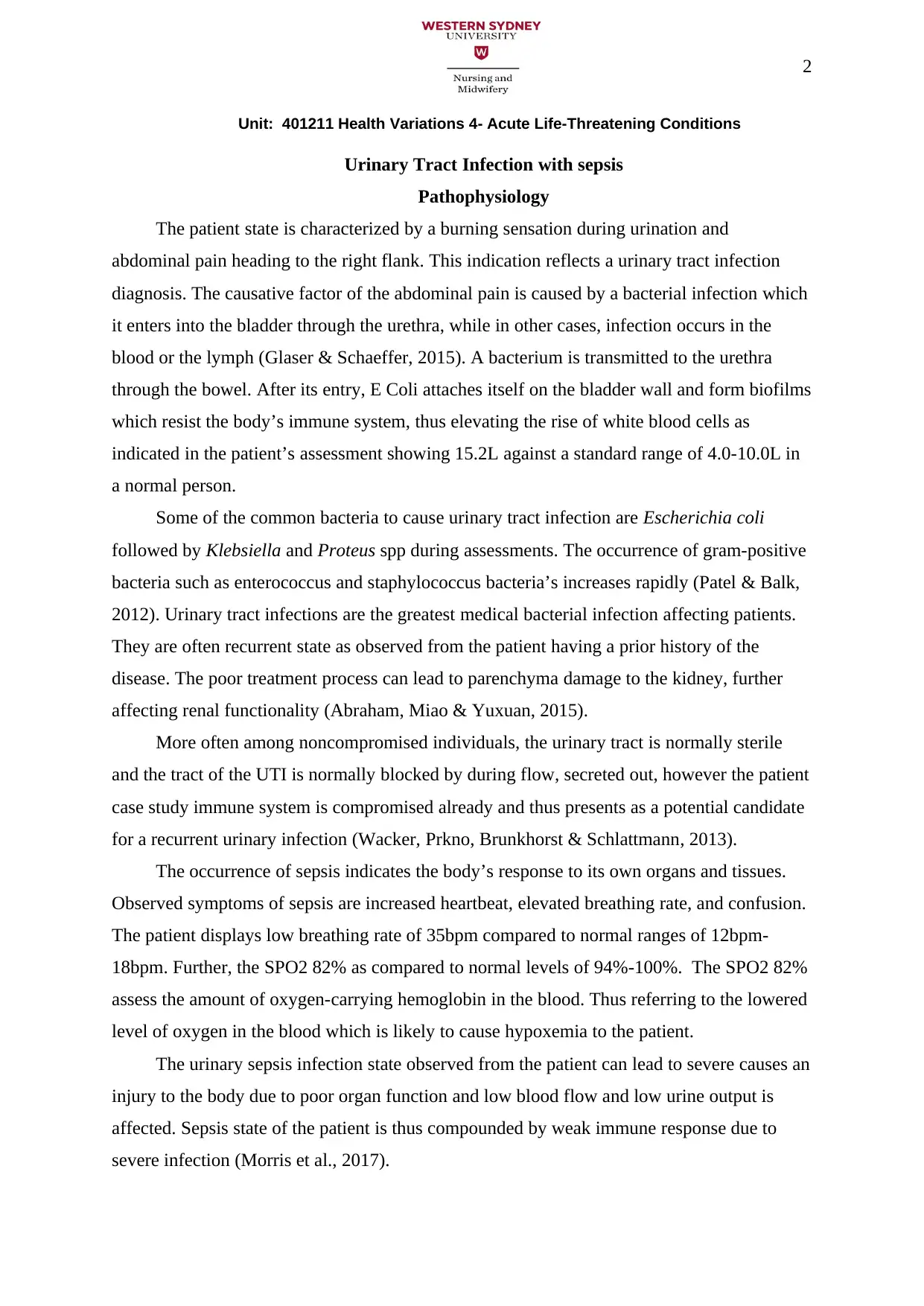
2
Unit: 401211 Health Variations 4- Acute Life-Threatening Conditions
Urinary Tract Infection with sepsis
Pathophysiology
The patient state is characterized by a burning sensation during urination and
abdominal pain heading to the right flank. This indication reflects a urinary tract infection
diagnosis. The causative factor of the abdominal pain is caused by a bacterial infection which
it enters into the bladder through the urethra, while in other cases, infection occurs in the
blood or the lymph (Glaser & Schaeffer, 2015). A bacterium is transmitted to the urethra
through the bowel. After its entry, E Coli attaches itself on the bladder wall and form biofilms
which resist the body’s immune system, thus elevating the rise of white blood cells as
indicated in the patient’s assessment showing 15.2L against a standard range of 4.0-10.0L in
a normal person.
Some of the common bacteria to cause urinary tract infection are Escherichia coli
followed by Klebsiella and Proteus spp during assessments. The occurrence of gram-positive
bacteria such as enterococcus and staphylococcus bacteria’s increases rapidly (Patel & Balk,
2012). Urinary tract infections are the greatest medical bacterial infection affecting patients.
They are often recurrent state as observed from the patient having a prior history of the
disease. The poor treatment process can lead to parenchyma damage to the kidney, further
affecting renal functionality (Abraham, Miao & Yuxuan, 2015).
More often among noncompromised individuals, the urinary tract is normally sterile
and the tract of the UTI is normally blocked by during flow, secreted out, however the patient
case study immune system is compromised already and thus presents as a potential candidate
for a recurrent urinary infection (Wacker, Prkno, Brunkhorst & Schlattmann, 2013).
The occurrence of sepsis indicates the body’s response to its own organs and tissues.
Observed symptoms of sepsis are increased heartbeat, elevated breathing rate, and confusion.
The patient displays low breathing rate of 35bpm compared to normal ranges of 12bpm-
18bpm. Further, the SPO2 82% as compared to normal levels of 94%-100%. The SPO2 82%
assess the amount of oxygen-carrying hemoglobin in the blood. Thus referring to the lowered
level of oxygen in the blood which is likely to cause hypoxemia to the patient.
The urinary sepsis infection state observed from the patient can lead to severe causes an
injury to the body due to poor organ function and low blood flow and low urine output is
affected. Sepsis state of the patient is thus compounded by weak immune response due to
severe infection (Morris et al., 2017).
Unit: 401211 Health Variations 4- Acute Life-Threatening Conditions
Urinary Tract Infection with sepsis
Pathophysiology
The patient state is characterized by a burning sensation during urination and
abdominal pain heading to the right flank. This indication reflects a urinary tract infection
diagnosis. The causative factor of the abdominal pain is caused by a bacterial infection which
it enters into the bladder through the urethra, while in other cases, infection occurs in the
blood or the lymph (Glaser & Schaeffer, 2015). A bacterium is transmitted to the urethra
through the bowel. After its entry, E Coli attaches itself on the bladder wall and form biofilms
which resist the body’s immune system, thus elevating the rise of white blood cells as
indicated in the patient’s assessment showing 15.2L against a standard range of 4.0-10.0L in
a normal person.
Some of the common bacteria to cause urinary tract infection are Escherichia coli
followed by Klebsiella and Proteus spp during assessments. The occurrence of gram-positive
bacteria such as enterococcus and staphylococcus bacteria’s increases rapidly (Patel & Balk,
2012). Urinary tract infections are the greatest medical bacterial infection affecting patients.
They are often recurrent state as observed from the patient having a prior history of the
disease. The poor treatment process can lead to parenchyma damage to the kidney, further
affecting renal functionality (Abraham, Miao & Yuxuan, 2015).
More often among noncompromised individuals, the urinary tract is normally sterile
and the tract of the UTI is normally blocked by during flow, secreted out, however the patient
case study immune system is compromised already and thus presents as a potential candidate
for a recurrent urinary infection (Wacker, Prkno, Brunkhorst & Schlattmann, 2013).
The occurrence of sepsis indicates the body’s response to its own organs and tissues.
Observed symptoms of sepsis are increased heartbeat, elevated breathing rate, and confusion.
The patient displays low breathing rate of 35bpm compared to normal ranges of 12bpm-
18bpm. Further, the SPO2 82% as compared to normal levels of 94%-100%. The SPO2 82%
assess the amount of oxygen-carrying hemoglobin in the blood. Thus referring to the lowered
level of oxygen in the blood which is likely to cause hypoxemia to the patient.
The urinary sepsis infection state observed from the patient can lead to severe causes an
injury to the body due to poor organ function and low blood flow and low urine output is
affected. Sepsis state of the patient is thus compounded by weak immune response due to
severe infection (Morris et al., 2017).
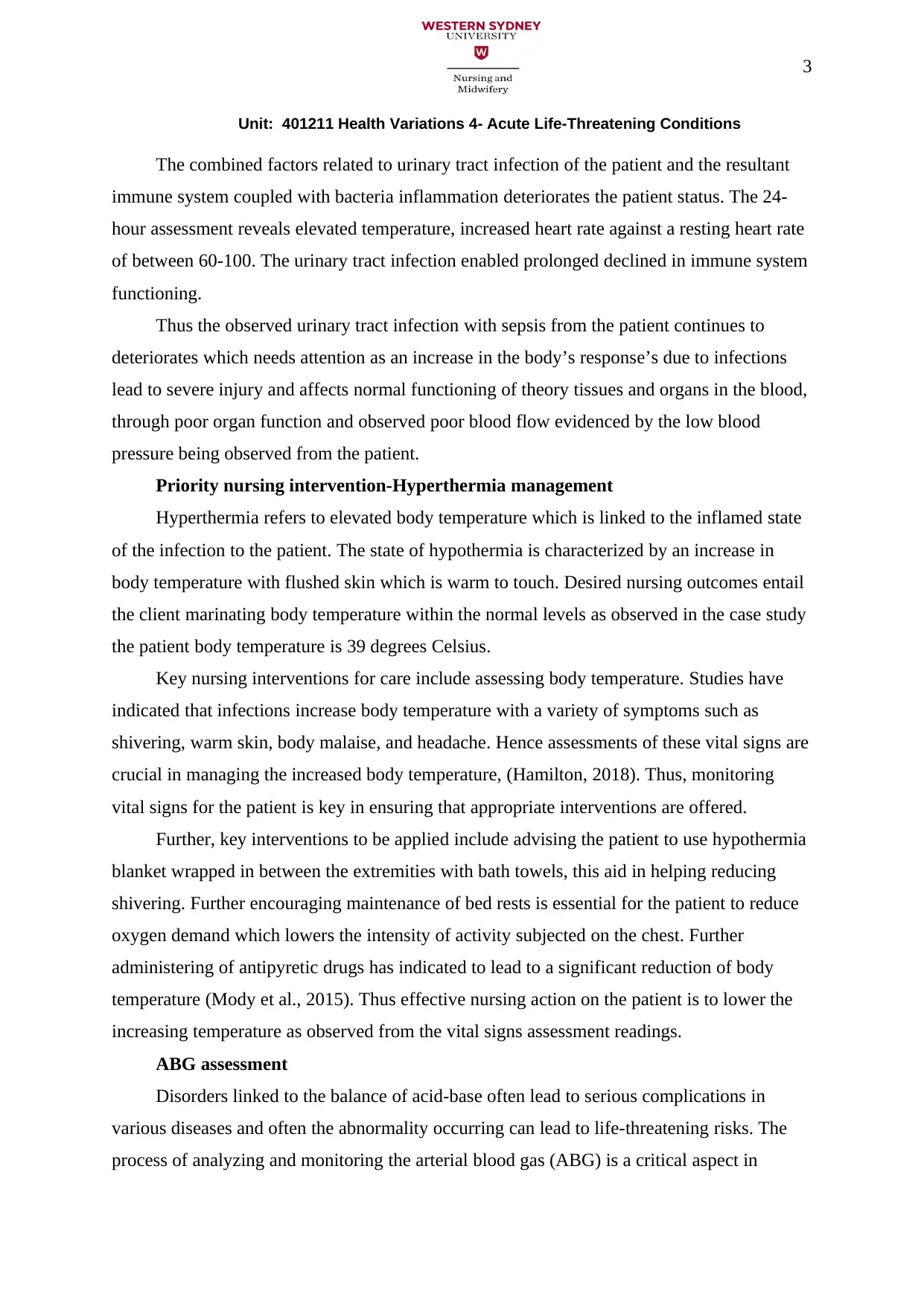
3
Unit: 401211 Health Variations 4- Acute Life-Threatening Conditions
The combined factors related to urinary tract infection of the patient and the resultant
immune system coupled with bacteria inflammation deteriorates the patient status. The 24-
hour assessment reveals elevated temperature, increased heart rate against a resting heart rate
of between 60-100. The urinary tract infection enabled prolonged declined in immune system
functioning.
Thus the observed urinary tract infection with sepsis from the patient continues to
deteriorates which needs attention as an increase in the body’s response’s due to infections
lead to severe injury and affects normal functioning of theory tissues and organs in the blood,
through poor organ function and observed poor blood flow evidenced by the low blood
pressure being observed from the patient.
Priority nursing intervention-Hyperthermia management
Hyperthermia refers to elevated body temperature which is linked to the inflamed state
of the infection to the patient. The state of hypothermia is characterized by an increase in
body temperature with flushed skin which is warm to touch. Desired nursing outcomes entail
the client marinating body temperature within the normal levels as observed in the case study
the patient body temperature is 39 degrees Celsius.
Key nursing interventions for care include assessing body temperature. Studies have
indicated that infections increase body temperature with a variety of symptoms such as
shivering, warm skin, body malaise, and headache. Hence assessments of these vital signs are
crucial in managing the increased body temperature, (Hamilton, 2018). Thus, monitoring
vital signs for the patient is key in ensuring that appropriate interventions are offered.
Further, key interventions to be applied include advising the patient to use hypothermia
blanket wrapped in between the extremities with bath towels, this aid in helping reducing
shivering. Further encouraging maintenance of bed rests is essential for the patient to reduce
oxygen demand which lowers the intensity of activity subjected on the chest. Further
administering of antipyretic drugs has indicated to lead to a significant reduction of body
temperature (Mody et al., 2015). Thus effective nursing action on the patient is to lower the
increasing temperature as observed from the vital signs assessment readings.
ABG assessment
Disorders linked to the balance of acid-base often lead to serious complications in
various diseases and often the abnormality occurring can lead to life-threatening risks. The
process of analyzing and monitoring the arterial blood gas (ABG) is a critical aspect in
Unit: 401211 Health Variations 4- Acute Life-Threatening Conditions
The combined factors related to urinary tract infection of the patient and the resultant
immune system coupled with bacteria inflammation deteriorates the patient status. The 24-
hour assessment reveals elevated temperature, increased heart rate against a resting heart rate
of between 60-100. The urinary tract infection enabled prolonged declined in immune system
functioning.
Thus the observed urinary tract infection with sepsis from the patient continues to
deteriorates which needs attention as an increase in the body’s response’s due to infections
lead to severe injury and affects normal functioning of theory tissues and organs in the blood,
through poor organ function and observed poor blood flow evidenced by the low blood
pressure being observed from the patient.
Priority nursing intervention-Hyperthermia management
Hyperthermia refers to elevated body temperature which is linked to the inflamed state
of the infection to the patient. The state of hypothermia is characterized by an increase in
body temperature with flushed skin which is warm to touch. Desired nursing outcomes entail
the client marinating body temperature within the normal levels as observed in the case study
the patient body temperature is 39 degrees Celsius.
Key nursing interventions for care include assessing body temperature. Studies have
indicated that infections increase body temperature with a variety of symptoms such as
shivering, warm skin, body malaise, and headache. Hence assessments of these vital signs are
crucial in managing the increased body temperature, (Hamilton, 2018). Thus, monitoring
vital signs for the patient is key in ensuring that appropriate interventions are offered.
Further, key interventions to be applied include advising the patient to use hypothermia
blanket wrapped in between the extremities with bath towels, this aid in helping reducing
shivering. Further encouraging maintenance of bed rests is essential for the patient to reduce
oxygen demand which lowers the intensity of activity subjected on the chest. Further
administering of antipyretic drugs has indicated to lead to a significant reduction of body
temperature (Mody et al., 2015). Thus effective nursing action on the patient is to lower the
increasing temperature as observed from the vital signs assessment readings.
ABG assessment
Disorders linked to the balance of acid-base often lead to serious complications in
various diseases and often the abnormality occurring can lead to life-threatening risks. The
process of analyzing and monitoring the arterial blood gas (ABG) is a critical aspect in
⊘ This is a preview!⊘
Do you want full access?
Subscribe today to unlock all pages.

Trusted by 1+ million students worldwide
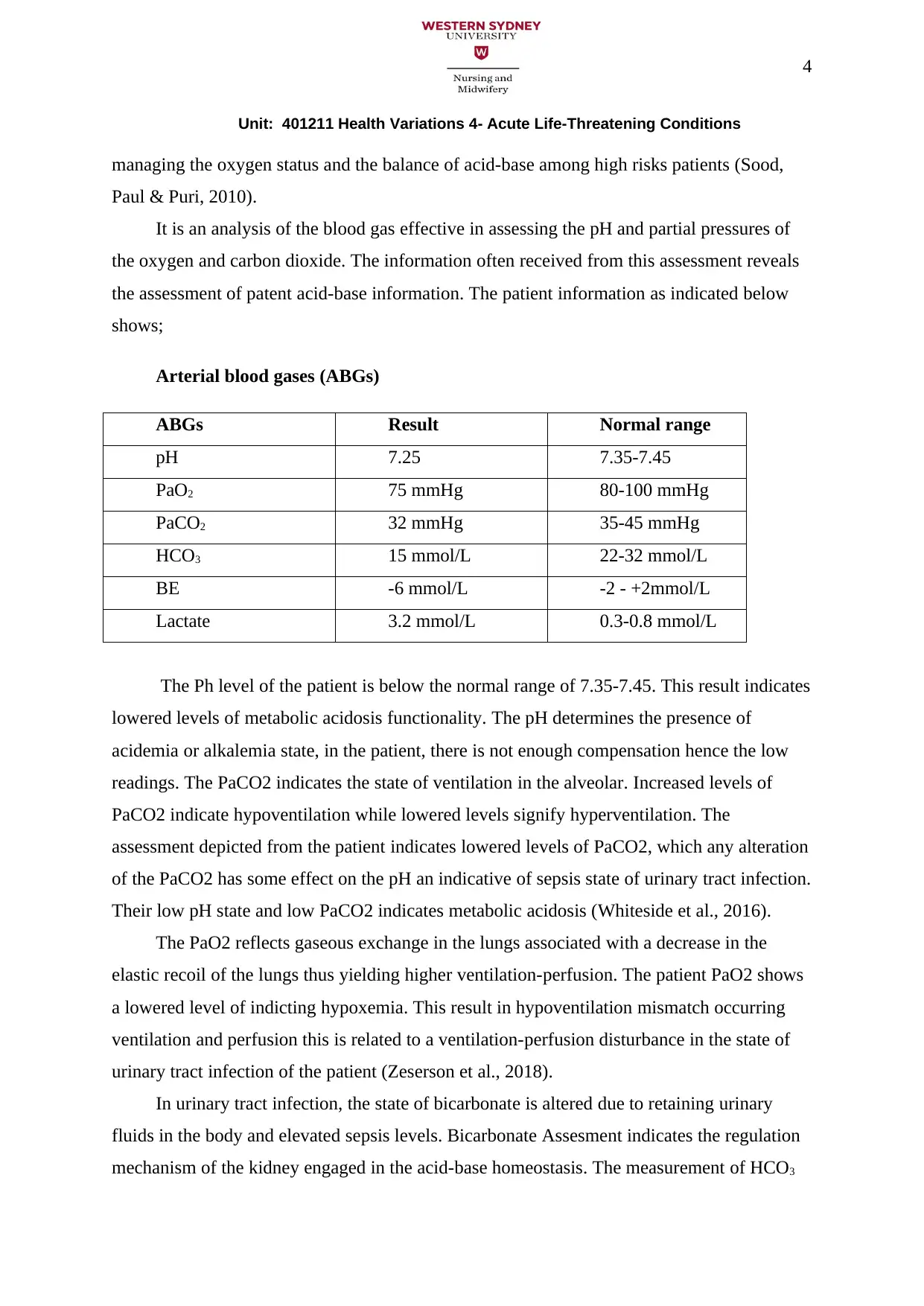
4
Unit: 401211 Health Variations 4- Acute Life-Threatening Conditions
managing the oxygen status and the balance of acid-base among high risks patients (Sood,
Paul & Puri, 2010).
It is an analysis of the blood gas effective in assessing the pH and partial pressures of
the oxygen and carbon dioxide. The information often received from this assessment reveals
the assessment of patent acid-base information. The patient information as indicated below
shows;
Arterial blood gases (ABGs)
ABGs Result Normal range
pH 7.25 7.35-7.45
PaO2 75 mmHg 80-100 mmHg
PaCO2 32 mmHg 35-45 mmHg
HCO3 15 mmol/L 22-32 mmol/L
BE -6 mmol/L -2 - +2mmol/L
Lactate 3.2 mmol/L 0.3-0.8 mmol/L
The Ph level of the patient is below the normal range of 7.35-7.45. This result indicates
lowered levels of metabolic acidosis functionality. The pH determines the presence of
acidemia or alkalemia state, in the patient, there is not enough compensation hence the low
readings. The PaCO2 indicates the state of ventilation in the alveolar. Increased levels of
PaCO2 indicate hypoventilation while lowered levels signify hyperventilation. The
assessment depicted from the patient indicates lowered levels of PaCO2, which any alteration
of the PaCO2 has some effect on the pH an indicative of sepsis state of urinary tract infection.
Their low pH state and low PaCO2 indicates metabolic acidosis (Whiteside et al., 2016).
The PaO2 reflects gaseous exchange in the lungs associated with a decrease in the
elastic recoil of the lungs thus yielding higher ventilation-perfusion. The patient PaO2 shows
a lowered level of indicting hypoxemia. This result in hypoventilation mismatch occurring
ventilation and perfusion this is related to a ventilation-perfusion disturbance in the state of
urinary tract infection of the patient (Zeserson et al., 2018).
In urinary tract infection, the state of bicarbonate is altered due to retaining urinary
fluids in the body and elevated sepsis levels. Bicarbonate Assesment indicates the regulation
mechanism of the kidney engaged in the acid-base homeostasis. The measurement of HCO3
Unit: 401211 Health Variations 4- Acute Life-Threatening Conditions
managing the oxygen status and the balance of acid-base among high risks patients (Sood,
Paul & Puri, 2010).
It is an analysis of the blood gas effective in assessing the pH and partial pressures of
the oxygen and carbon dioxide. The information often received from this assessment reveals
the assessment of patent acid-base information. The patient information as indicated below
shows;
Arterial blood gases (ABGs)
ABGs Result Normal range
pH 7.25 7.35-7.45
PaO2 75 mmHg 80-100 mmHg
PaCO2 32 mmHg 35-45 mmHg
HCO3 15 mmol/L 22-32 mmol/L
BE -6 mmol/L -2 - +2mmol/L
Lactate 3.2 mmol/L 0.3-0.8 mmol/L
The Ph level of the patient is below the normal range of 7.35-7.45. This result indicates
lowered levels of metabolic acidosis functionality. The pH determines the presence of
acidemia or alkalemia state, in the patient, there is not enough compensation hence the low
readings. The PaCO2 indicates the state of ventilation in the alveolar. Increased levels of
PaCO2 indicate hypoventilation while lowered levels signify hyperventilation. The
assessment depicted from the patient indicates lowered levels of PaCO2, which any alteration
of the PaCO2 has some effect on the pH an indicative of sepsis state of urinary tract infection.
Their low pH state and low PaCO2 indicates metabolic acidosis (Whiteside et al., 2016).
The PaO2 reflects gaseous exchange in the lungs associated with a decrease in the
elastic recoil of the lungs thus yielding higher ventilation-perfusion. The patient PaO2 shows
a lowered level of indicting hypoxemia. This result in hypoventilation mismatch occurring
ventilation and perfusion this is related to a ventilation-perfusion disturbance in the state of
urinary tract infection of the patient (Zeserson et al., 2018).
In urinary tract infection, the state of bicarbonate is altered due to retaining urinary
fluids in the body and elevated sepsis levels. Bicarbonate Assesment indicates the regulation
mechanism of the kidney engaged in the acid-base homeostasis. The measurement of HCO3
Paraphrase This Document
Need a fresh take? Get an instant paraphrase of this document with our AI Paraphraser
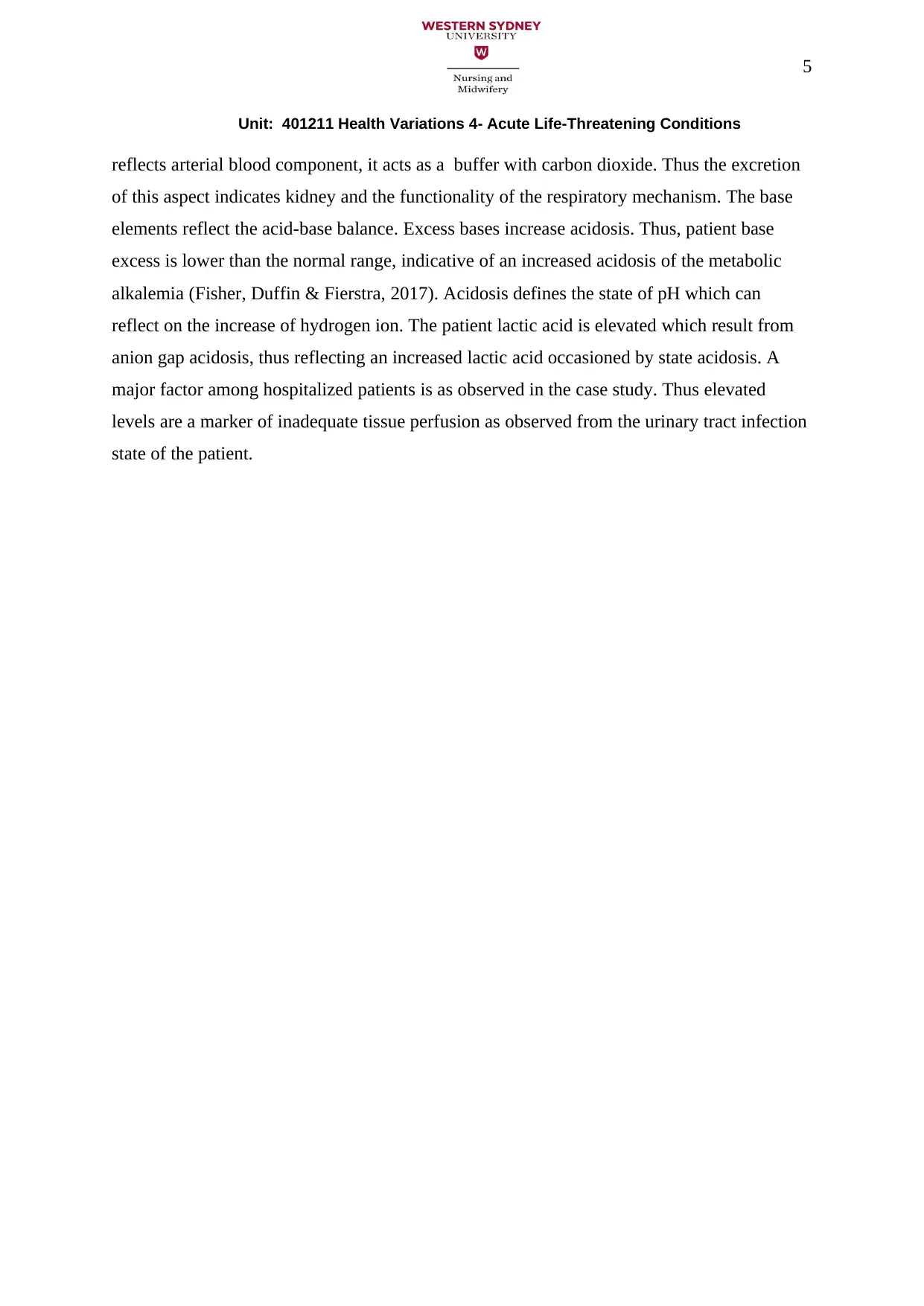
5
Unit: 401211 Health Variations 4- Acute Life-Threatening Conditions
reflects arterial blood component, it acts as a buffer with carbon dioxide. Thus the excretion
of this aspect indicates kidney and the functionality of the respiratory mechanism. The base
elements reflect the acid-base balance. Excess bases increase acidosis. Thus, patient base
excess is lower than the normal range, indicative of an increased acidosis of the metabolic
alkalemia (Fisher, Duffin & Fierstra, 2017). Acidosis defines the state of pH which can
reflect on the increase of hydrogen ion. The patient lactic acid is elevated which result from
anion gap acidosis, thus reflecting an increased lactic acid occasioned by state acidosis. A
major factor among hospitalized patients is as observed in the case study. Thus elevated
levels are a marker of inadequate tissue perfusion as observed from the urinary tract infection
state of the patient.
Unit: 401211 Health Variations 4- Acute Life-Threatening Conditions
reflects arterial blood component, it acts as a buffer with carbon dioxide. Thus the excretion
of this aspect indicates kidney and the functionality of the respiratory mechanism. The base
elements reflect the acid-base balance. Excess bases increase acidosis. Thus, patient base
excess is lower than the normal range, indicative of an increased acidosis of the metabolic
alkalemia (Fisher, Duffin & Fierstra, 2017). Acidosis defines the state of pH which can
reflect on the increase of hydrogen ion. The patient lactic acid is elevated which result from
anion gap acidosis, thus reflecting an increased lactic acid occasioned by state acidosis. A
major factor among hospitalized patients is as observed in the case study. Thus elevated
levels are a marker of inadequate tissue perfusion as observed from the urinary tract infection
state of the patient.
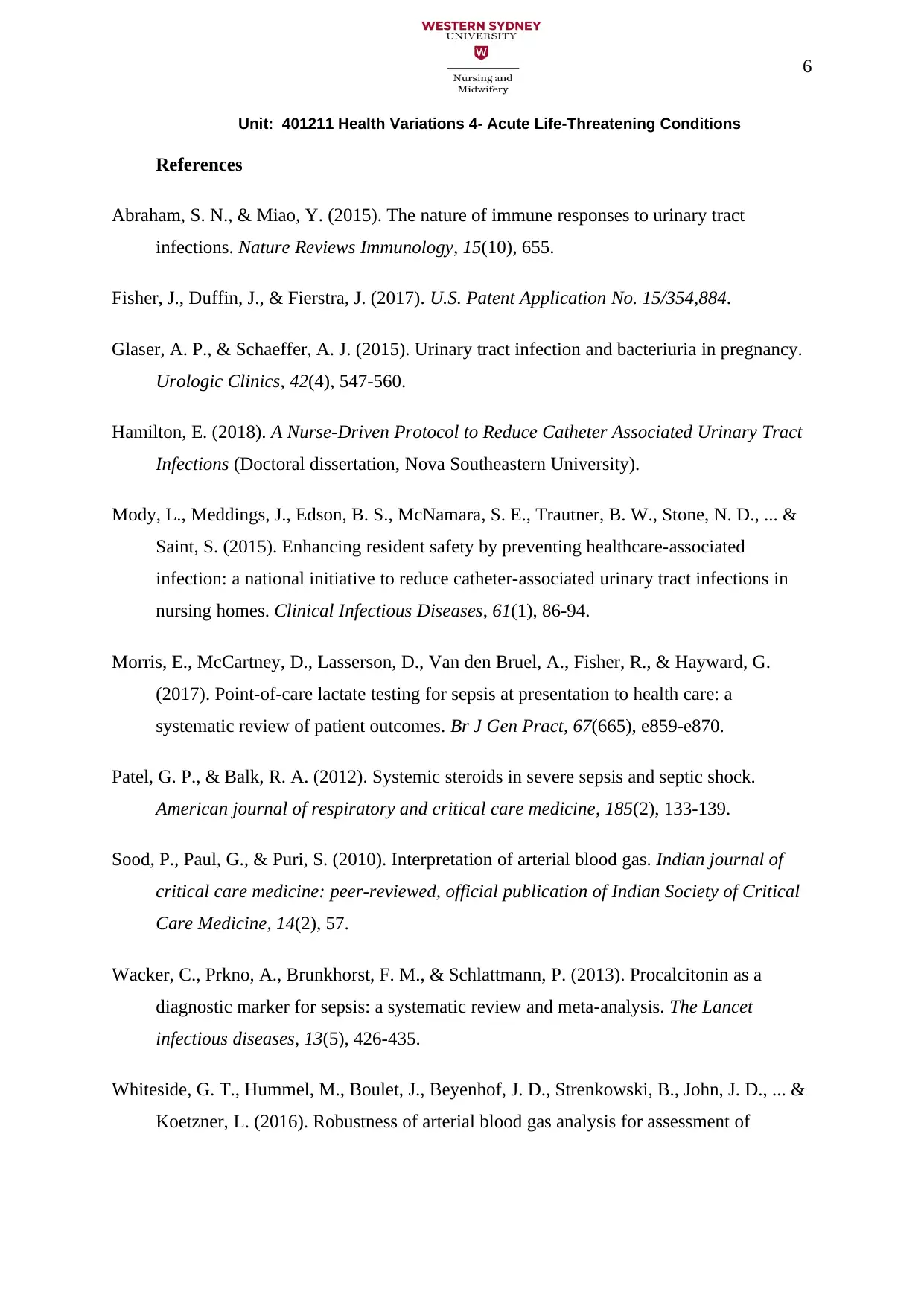
6
Unit: 401211 Health Variations 4- Acute Life-Threatening Conditions
References
Abraham, S. N., & Miao, Y. (2015). The nature of immune responses to urinary tract
infections. Nature Reviews Immunology, 15(10), 655.
Fisher, J., Duffin, J., & Fierstra, J. (2017). U.S. Patent Application No. 15/354,884.
Glaser, A. P., & Schaeffer, A. J. (2015). Urinary tract infection and bacteriuria in pregnancy.
Urologic Clinics, 42(4), 547-560.
Hamilton, E. (2018). A Nurse-Driven Protocol to Reduce Catheter Associated Urinary Tract
Infections (Doctoral dissertation, Nova Southeastern University).
Mody, L., Meddings, J., Edson, B. S., McNamara, S. E., Trautner, B. W., Stone, N. D., ... &
Saint, S. (2015). Enhancing resident safety by preventing healthcare-associated
infection: a national initiative to reduce catheter-associated urinary tract infections in
nursing homes. Clinical Infectious Diseases, 61(1), 86-94.
Morris, E., McCartney, D., Lasserson, D., Van den Bruel, A., Fisher, R., & Hayward, G.
(2017). Point-of-care lactate testing for sepsis at presentation to health care: a
systematic review of patient outcomes. Br J Gen Pract, 67(665), e859-e870.
Patel, G. P., & Balk, R. A. (2012). Systemic steroids in severe sepsis and septic shock.
American journal of respiratory and critical care medicine, 185(2), 133-139.
Sood, P., Paul, G., & Puri, S. (2010). Interpretation of arterial blood gas. Indian journal of
critical care medicine: peer-reviewed, official publication of Indian Society of Critical
Care Medicine, 14(2), 57.
Wacker, C., Prkno, A., Brunkhorst, F. M., & Schlattmann, P. (2013). Procalcitonin as a
diagnostic marker for sepsis: a systematic review and meta-analysis. The Lancet
infectious diseases, 13(5), 426-435.
Whiteside, G. T., Hummel, M., Boulet, J., Beyenhof, J. D., Strenkowski, B., John, J. D., ... &
Koetzner, L. (2016). Robustness of arterial blood gas analysis for assessment of
Unit: 401211 Health Variations 4- Acute Life-Threatening Conditions
References
Abraham, S. N., & Miao, Y. (2015). The nature of immune responses to urinary tract
infections. Nature Reviews Immunology, 15(10), 655.
Fisher, J., Duffin, J., & Fierstra, J. (2017). U.S. Patent Application No. 15/354,884.
Glaser, A. P., & Schaeffer, A. J. (2015). Urinary tract infection and bacteriuria in pregnancy.
Urologic Clinics, 42(4), 547-560.
Hamilton, E. (2018). A Nurse-Driven Protocol to Reduce Catheter Associated Urinary Tract
Infections (Doctoral dissertation, Nova Southeastern University).
Mody, L., Meddings, J., Edson, B. S., McNamara, S. E., Trautner, B. W., Stone, N. D., ... &
Saint, S. (2015). Enhancing resident safety by preventing healthcare-associated
infection: a national initiative to reduce catheter-associated urinary tract infections in
nursing homes. Clinical Infectious Diseases, 61(1), 86-94.
Morris, E., McCartney, D., Lasserson, D., Van den Bruel, A., Fisher, R., & Hayward, G.
(2017). Point-of-care lactate testing for sepsis at presentation to health care: a
systematic review of patient outcomes. Br J Gen Pract, 67(665), e859-e870.
Patel, G. P., & Balk, R. A. (2012). Systemic steroids in severe sepsis and septic shock.
American journal of respiratory and critical care medicine, 185(2), 133-139.
Sood, P., Paul, G., & Puri, S. (2010). Interpretation of arterial blood gas. Indian journal of
critical care medicine: peer-reviewed, official publication of Indian Society of Critical
Care Medicine, 14(2), 57.
Wacker, C., Prkno, A., Brunkhorst, F. M., & Schlattmann, P. (2013). Procalcitonin as a
diagnostic marker for sepsis: a systematic review and meta-analysis. The Lancet
infectious diseases, 13(5), 426-435.
Whiteside, G. T., Hummel, M., Boulet, J., Beyenhof, J. D., Strenkowski, B., John, J. D., ... &
Koetzner, L. (2016). Robustness of arterial blood gas analysis for assessment of
⊘ This is a preview!⊘
Do you want full access?
Subscribe today to unlock all pages.

Trusted by 1+ million students worldwide
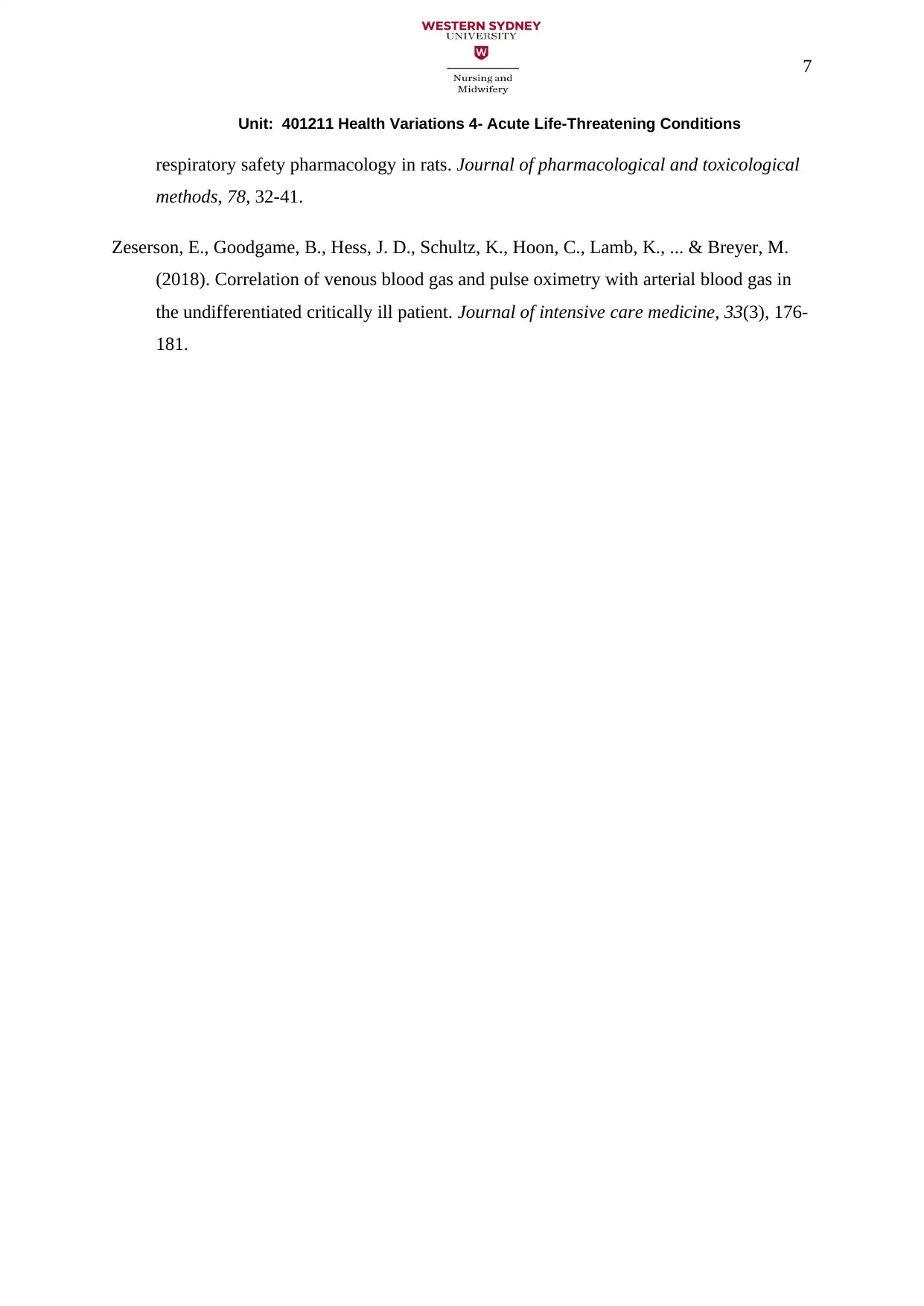
7
Unit: 401211 Health Variations 4- Acute Life-Threatening Conditions
respiratory safety pharmacology in rats. Journal of pharmacological and toxicological
methods, 78, 32-41.
Zeserson, E., Goodgame, B., Hess, J. D., Schultz, K., Hoon, C., Lamb, K., ... & Breyer, M.
(2018). Correlation of venous blood gas and pulse oximetry with arterial blood gas in
the undifferentiated critically ill patient. Journal of intensive care medicine, 33(3), 176-
181.
Unit: 401211 Health Variations 4- Acute Life-Threatening Conditions
respiratory safety pharmacology in rats. Journal of pharmacological and toxicological
methods, 78, 32-41.
Zeserson, E., Goodgame, B., Hess, J. D., Schultz, K., Hoon, C., Lamb, K., ... & Breyer, M.
(2018). Correlation of venous blood gas and pulse oximetry with arterial blood gas in
the undifferentiated critically ill patient. Journal of intensive care medicine, 33(3), 176-
181.
1 out of 7
Related Documents
Your All-in-One AI-Powered Toolkit for Academic Success.
+13062052269
info@desklib.com
Available 24*7 on WhatsApp / Email
![[object Object]](/_next/static/media/star-bottom.7253800d.svg)
Unlock your academic potential
Copyright © 2020–2025 A2Z Services. All Rights Reserved. Developed and managed by ZUCOL.





